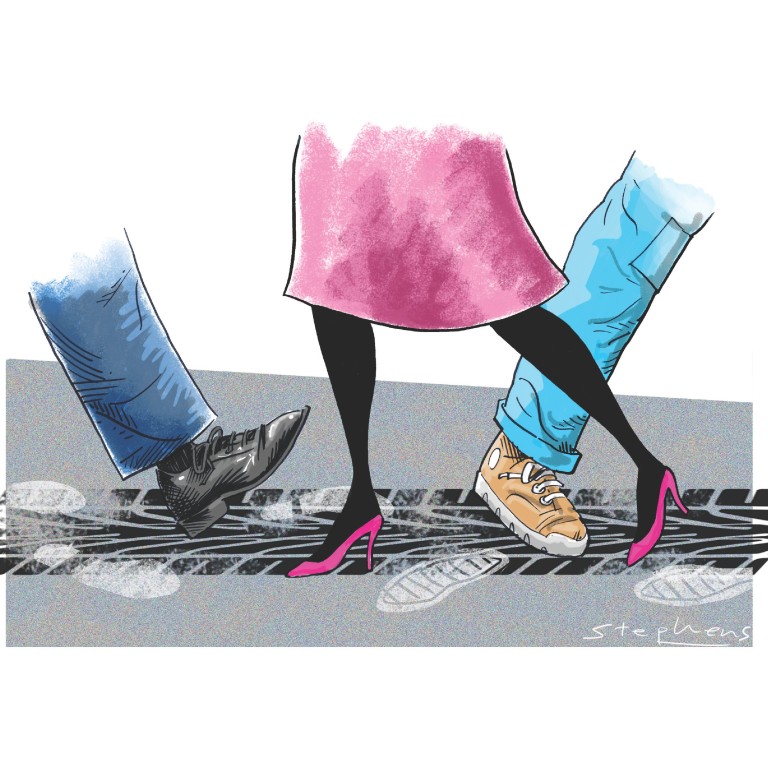
Make walking a healthy feature of urban living in Hong Kong
Kwong Sum Yin says Hong Kong must begin to prioritise pedestrian needs in its transport blueprint to curb a reliance on emissions-spewing cars, thereby improving public health
Last week, Secretary for Transport and Housing Anthony Cheung Bing-leung responded to the report on road traffic congestion submitted by the Transport Advisory Committee. The government has adopted the committee's 12-point proposal, which includes measures such as raising the first registration tax, diesel levy and metered parking charges; as well as stiffer penalties for and stricter enforcement of congestion-related offences.
Unsurprisingly, such measures drew motorists' opposition and the discussion was quickly relegated to an outcry over the rise in fees. According to the report, private cars accounted for 70 per cent of all licensed vehicles in 2013, and their growth alone over the decade to 2013 constituted about 87 per cent of the total vehicle increase. As a result, the average car speed in urban areas has dropped by about 11 per cent, with some traffic corridors recording 10km/h during morning peak hours.
Bold action is needed to tackle this pressing issue. However, if government officials think that charging is the key to a long-term solution, they are wrong. Traffic management has long been restricted to vehicular considerations, but there is another part of the puzzle that is missing in the current transport planning discussion: pedestrians. We have therefore delivered a petition to the Transport and Housing Bureau, calling for the rights of pedestrians to be factored into transport planning.
Hong Kong has a history of neglecting pedestrian needs in its transport planning. Even though the "Third Comprehensive Transport Study" of 1999 clearly said that "walking is an important mode and that facilities for pedestrians need to be incorporated into a transport plan", this approach has not been truly adopted.
We have seen less than satisfactory progress in creating access to public transport, direct pedestrian links and the pedestrianisation of local streets. Pedestrians' rights are always put second, behind those of vehicles.
Yet, a growing number of cities are limiting cars in some areas and rediscovering the oldest transport mode for humankind as part of the solution to tackle congestion and improve citizens' health and quality of life. London is a forerunner. Transport for London has been promoting walking and studying both facilities for and barriers to walking. Back in 2004, they set a concrete target to boost the number of walking trips per person by 10 per cent by 2015.
In Paris, Mayor Anne Hidalgo plans to turn the right bank of the River Seine into a car-free zone, following her predecessor's successful pedestrianisation of the left bank. In her plan, 2,700 vehicles that pass along the highways during peak hours will be relocated elsewhere to allow riverside gardens, games areas and strolling people to take over.
Last month, Civic Exchange and the Hong Kong University of Science and Technology released a report revealing the extent of particulate matter pollution along Hong Kong's tramway. They discovered that, in Central and Causeway Bay, the PM2.5 daily average concentrations exceeded World Health Organisation standards for about 280 days a year. Des Voeux Road Central was the most polluted area.
One viable solution is to set up a pedestrian-and tram-only precinct in that area, as advocated by the Hong Kong Institute of Planners. It would encourage citizens to walk, which promotes health, and provide a public space in a core commercial area where people can freely hang out.
A recently released book, titled documents the efforts of a South Korean neighbourhood to tackle the problem. Residents in one district in Suwon, south of Seoul, took part in an experiment: not using their cars for a month. During that time, the sight of cars clogging the streets and people warding off fumes disappeared. The community enjoyed car-free streets; cafes and restaurants added new pavement seating and citizens tried out the 400 bikes and electric scooters offered temporarily by the government. At the end of the month, citizens became much more open to this sustainable alternative. Some changes were enforced shortly after the experiment, such as enacting no-parking areas, speed restrictions and car-free weekends.
Hong Kong can certainly borrow from this successful example and start by implementing a car-free day or weekend in an area like Des Voeux Road Central. By offering attractive alternatives, people may change their minds that transport by cars is essential to urban living.
Anthony Cheung has proclaimed that Hong Kong is a suitable city for walking, but the current transport planning reveals few decisive measures giving more rights to pedestrians, let alone innovative approaches like those in South Korea. Cars continue to dominate the roads in Hong Kong, and it is common to see chauffeurs waiting illegally in their cars with idling engines, and double-parking along our most congested roads. We need our leaders to have a vision for a different future.
Transport defines our quality of life. We need fewer cars on the roads and more people using low-emission public transport, while redeveloping pedestrian and cycling networks to turn Hong Kong into a people-oriented city.
The government should adopt this new paradigm of sustainable transport. It's time to start thinking about moving people rather than cars.
